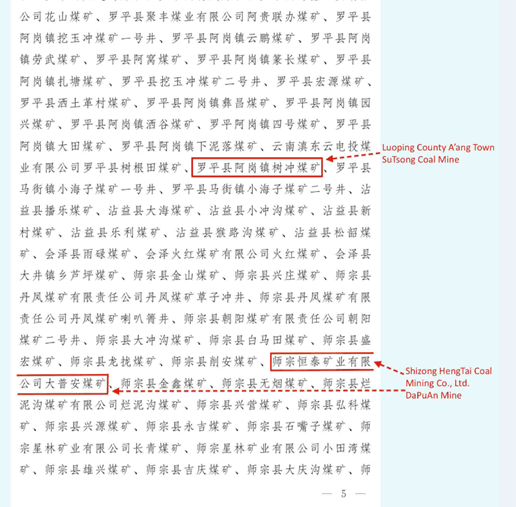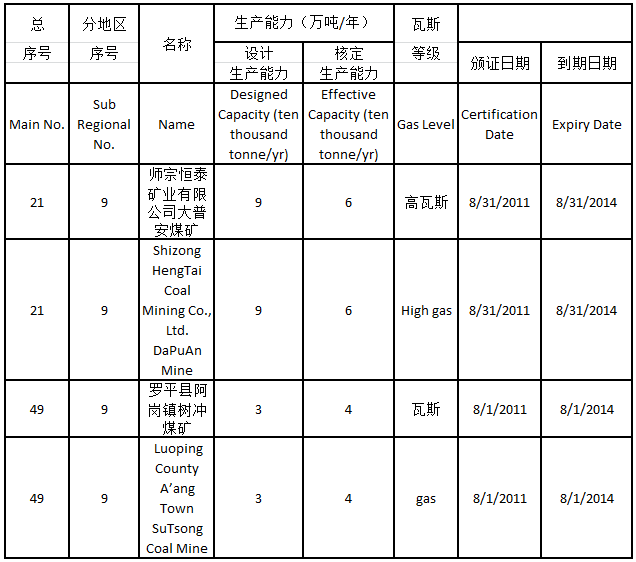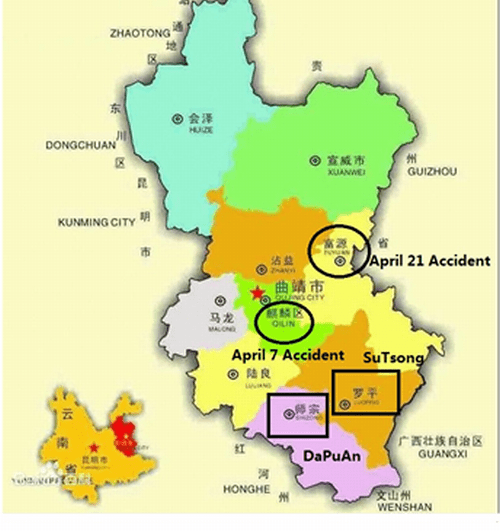In today’s report, Part Four of our series of “In the public Interest” reports on L & L Energy (LLEN), GeoInvesting covers how recent events and government documents call into question LLEN’s claimed historical coal production.
1. In response to recent mining accidents, the Yunnan Provincial Government issued a suspension order listing 992 coalmines (including DaPuAn and SuTsong) with less than 90k metric tons annual output.
2. Chinese government websites disclose much lower production capacity figures for the DaPuAn and SuTsong mines than reported by LLEN.
3. We conclude that LLEN has exaggerated the historical production and capacity of the DaPuAn and SuTsong mines.
As GeoInvesting originally reported here, two major coal-mining accidents recently occurred (April 7, 2014 and April 21, 2014) in Qujing, Yunnan, resulting in the deaths of 35 people. Both accidents occurred in the vicinity of the DaPuAn and SuTsong mines that L & L Energy (LLEN) purports to own, as shown below:
Following a major accident, safety inspection checks and mine shutdowns in China could last for a year or more. This was the case following the November 2011 Shizong Sizhuangmine disaster that led to the 2012 closures of the Hong Xing coal washing facility and the ZoneLin coking plant. Only after May 2013 did the coal production in the area recover.
Following the first accident, on April 15, 2014 the Yunnan Provincial Government ordered the suspension of mining at 992 coalmines (the published list can be found here.) The Yunnan Coalmine Safety Inspection Bureau summarizedthe suspension order as follows:
“On April 15, the Yunnan Provincial Government ordered all provincial coalmines under 90,000 metric tons annual output are suspended for rectification, and also published a list of the 992 coalmines suspended.”
The DaPuAn and SuTsong Coalmines are on the Suspension List
According to LLEN’s SEC filings, the legal names of the DaPuAn and SuTsong coalmines are “Shizong HengTai Coal Mining Co., Ltd. DaPuAn Mine” and “Luoping County A’ang Town SuTsong Coal Mine.” The full legal names of the two mines appear on page five of the suspension list, as shown in the snapshot below:

LLEN Current Management Using The Same Playbook As Old Management?
According to the list, the Yunnan Provincial Government ordered the suspension of production for both DaPuAn and SuTsong on April 15, 2014. Yet almost a month later LLEN’s management team still has not disclosed any 8-k filing regarding this issue.
Even more disturbing, since the government list contains coalmines with annual output below 90,000 metric tons, LLEN’s reported annual historical coal production of more than 90,000 metric tons from the DaPuAn and SuTsong mines is called into question.
The following table shows the coal productionLLEN reported for each of the two mines for the fiscal years ended April 30, 2009 through April 30, 2013 in its 10-K filings to the SEC:
| DaPuAn | SuTsong | ||
| Fiscal Year Ended April 30, | Annual Production (tons) | Fiscal Year Ended April 30, | Annual Production (tons) |
| 2009 | 121,159 | 2009 | 83,852 |
| 2010 | 255,994 | 2010 | 115,623 |
| 2011 | 245,545 | 2011 | 122,081 |
| 2012 | 129,505 | 2012 | 95,456 |
| 2013 | 228,298 | 2013 | 131,707 |
LLEN’s management needs to explain why the DaPuAn and SuTsong mines appear on the government list of 992 suspended mines with <90,000 metric tons annual output.
Yunnan Coalmine Safety Inspection Bureau Website Reports the Capacity of the DaPuAn and SuTsong Mines
Ever since its purported acquisition of the DaPuAn and SuTsong mines on May 1, 2008, LLEN has repeatedly reported the production capacity of the two mines in its annual reports as follows:
| Mines | Production Capacity (tons) |
| DaPuAn | 150,000 |
| SuTsong | 90,000 |
LLEN’s capacity figures are contradicted by recent reports published by the Yunnan Coalmine Safety Inspection Bureau.
On March 18, 2014 the Yunnan Coalmine Safety Inspection Bureau published a table titled “2014 Special Inspection of Coal Mine Safety Permit Holders with a List of Coal Mines” that can be found by clicking the Chinese link provided on the Yunnan Coalmine Safety website.
According to thetable, excerpted below, the DaPuAn and SuTsong mines’ designed capacities are 90,000 and 30,000 metric tons, respectively.

Note: “Designed Capacity” is the theoretical annual capacity of the coalmine for engineering purposes. “EffectiveCapacity” is the practical annual capacity of the coalmine.
On November 22, 2013 the Yunnan Coalmine Safety Inspection Bureau published a table titled “Yunnan Province Newly Built Expansion Projects Record Documents (until 2014.4.16).”The table can be found by clicking the Chinese link provided on theYunnan Coal Mine Safety Inspection website.
The SuTsong mine, No.45 on the table (excerpted below), had an original designed capacity of 30,000 metric tons per year and was later approved to expand to 90,000 metric tons per year. According to an announcementon the Qujing City, Luoping County, Ministry of Commerce website, the SuTsong mine planned to begin its expansion construction at the end of 2012. According to the table set forth below from the Yunnan Coal Mine Safety Inspection website, the construction period should take 17 months.
According to the Qujing Environmental Bureau, the SuTsong mine’s environmental approvaldate was January 14, 2014. Therefore we conclude that the SuTsong mine’s production capacity was still only 30,000 metric tons per year until early 2014.

Note: The DaPuAn mine did not appear on the government list of mine expansions.
GeoInvesting is aware that LLEN claims to exceed the production capacity of its mines. Per LLEN’s 2013 10-K:
“According to Chinese government regulation, a coal mine can produce up to the production capacity set forth in the mining production permit. However, depending on the market demand for coal, especially during the high demand season in the winter, the local government does allow coal mines to produce more than the production capacity that year or use the unused capacity from previous years without giving specific written approval.”
So just how much more coal production did LLEN report to the SEC compared to the Chinese government reported capacity? Using the capacity for the DaPuAn and SuTsong mines found on the various Chinese government websites, LLEN’s overproduction was as follows:
| DaPuAn | |||
| Fiscal Year Ended April 30, | Capacity (t) | Annual Production (tons) | Overproduction (%) |
| 2009 | 90,000 | 121,159 | 35% |
| 2010 | 90,000 | 255,994 | 184% |
| 2011 | 90,000 | 245,545 | 173% |
| 2012 | 90,000 | 129,505 | 44% |
| 2013 | 90,000 | 228,298 | 154% |
| SuTsong | |||
| Fiscal Year Ended April 30, | Capacity (t) | Annual Production (tons) | Overproduction (%) |
| 2009 | 30,000 | 83,852 | 180% |
| 2010 | 30,000 | 115,623 | 285% |
| 2011 | 30,000 | 122,081 | 307% |
| 2012 | 30,000 | 95,456 | 218% |
| 2013 | 30,000 | 131,707 | 339% |
Conclusion:
As we have shown, the Yunnan Provincial Government reacted to the recent major mining accidents by issuing a suspension order listing 992 coalmines (including DaPuAn and SuTsong) with <90k metric tons per year output. Various Chinese government websites confirm lower production capacity figures for the DaPuAn and SuTsong mines than reported by LLEN. Given these latest events we are left with the conclusion that LLEN has exaggerated the historical production and capacity of the two mines.
Aside from the tragic circumstances that have brought to light yet additional misrepresentation by LLEN, we continue to wait for the current management of LLEN to step forward to give timely, accurate, investor-responsive information. Instead what we have seen is a steady pace of more of the same. Against all of our hopes it appears clear to us that the current management of LLEN is no better than the former management.
